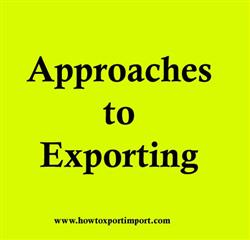Approaches to Exporting
The way a company chooses to export its products can have a significant effect on its export plan and specific marketing strategies. The basic distinction among approaches to exporting relates to a company's level of involvement in the export process. There are at least four approaches, which may be used alone or in combination:
Passively supplying to domestic buyers who then export: These sales are indistinguishable from other domestic sales as far as the original seller is concerned. Someone else has decided that the product in question meets foreign demand. That party takes all the risk and handles all of the exporting details, in some cases without even the awareness of the original seller.
 Seeking out domestic buyers who represent foreign end users or customers: Many foreign corporations, trading companies, government agencies, distributors and retailers purchase for export. These buyers procure goods from domestic market and export them on a large scale. In this case a company may know its product is being exported, but it is still the buyer who assumes the risk and handles the details of exporting.
Seeking out domestic buyers who represent foreign end users or customers: Many foreign corporations, trading companies, government agencies, distributors and retailers purchase for export. These buyers procure goods from domestic market and export them on a large scale. In this case a company may know its product is being exported, but it is still the buyer who assumes the risk and handles the details of exporting.
Exporting Indirectly through Intermediaries: Under this approach, a firm engages the services of an intermediary capable of finding foreign markets and buyers for its products. In India, export houses and trading companies act as such intermediary. In this case, the exporter can exercise a considerable control over the process and other benefits of exporting.
Exporting Directly: Under this approach, the exporter Personally handles every aspect of the exporting process from market research and planning to foreign distribution and collections. Consequently, a significant commitment of management time and attention is required to achieve good results. However, this approach may also be the best way to achieve maximum profits and long-term growth.
Triangular export
Triangular shipment
Types of Insurance Documents.
What happens if overseas buyer not paid export bills discounted.
What happens if proper tracking of goods not effected in export import business?
What happens if your buyer rejects cargo? What are the major problems if consignee not taken delivery of cargo?
What happens, if Bank not received money from buyer after discounting of export bills?
Transferability of Bill of Lading
Transhipment - A redefinition
Travelers to India under import duty exemption, Frequently Asked Questions Part 2
How to make DA mode of payment safe
How to make delay in delivery of Shipment?
How to minimize import cargo clearance time? An open logic proposal to WTO
What happens, if cargo not cleared by importer
What happens, if HAWB number marks wrongly
What happens, once Bill of Entry for Imports files?
What is ‘Combined Bill of Lading’
How to obtain a duplicate BL, if original bill of lading lost.
How to obtain GSP - Certificate of Origin?
How to obtain Phyto sanitary certificate. What is phytosanitary certification
How to obtain waiver on detention/ demurrage on imported goods/container from Shipping company/CFS
What is ‘Late BL release charges’
What is ATA carnet and how ATA carnet works?
What is Bank Guarantee to customs in Import
What is Bond execution with customs in imports and exports
Transferability of Bill of Lading
Registration required to export from Costa Rica
Import Customs processes in Costa Rica
Import Registration and import Licence procedures in Costa Rica
How to export from Bolivia?
How to Import to Bolivia?
How to import to India from Bolivia?
Click here to know GST rate on Goods and Services
GST Exemption list of goods and services
Find HSN number or Service tariff code for GST
GST registration guidelines
Indian GST Laws
How to export your goods?